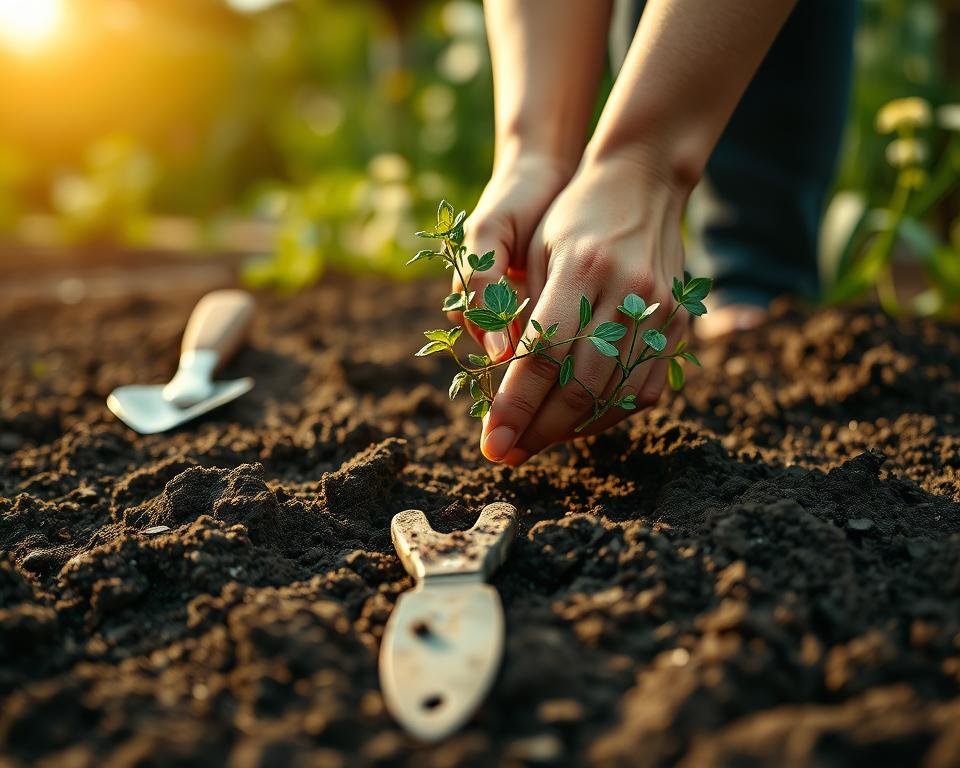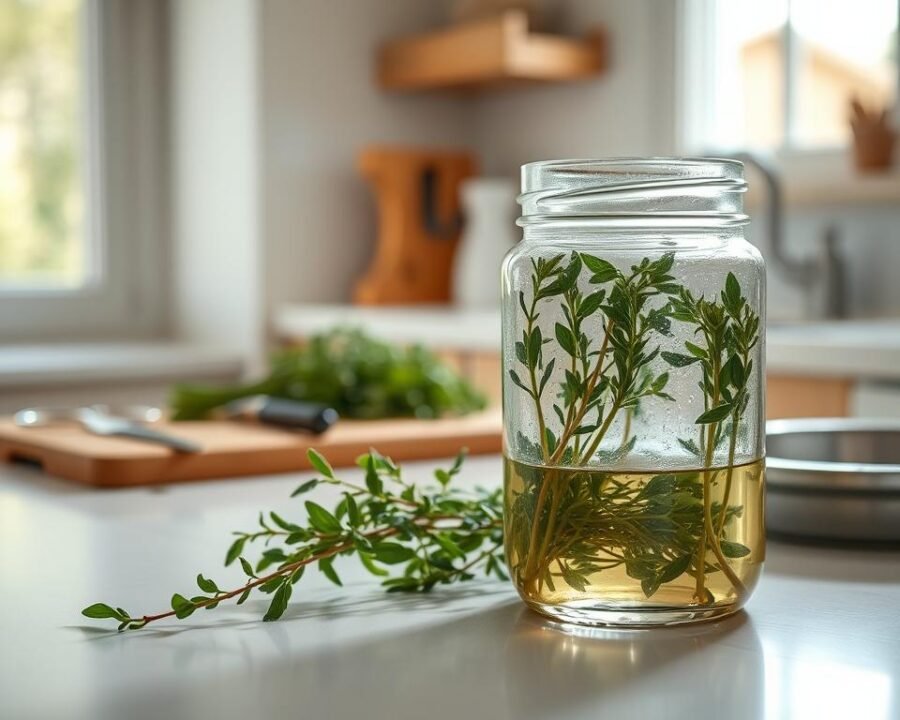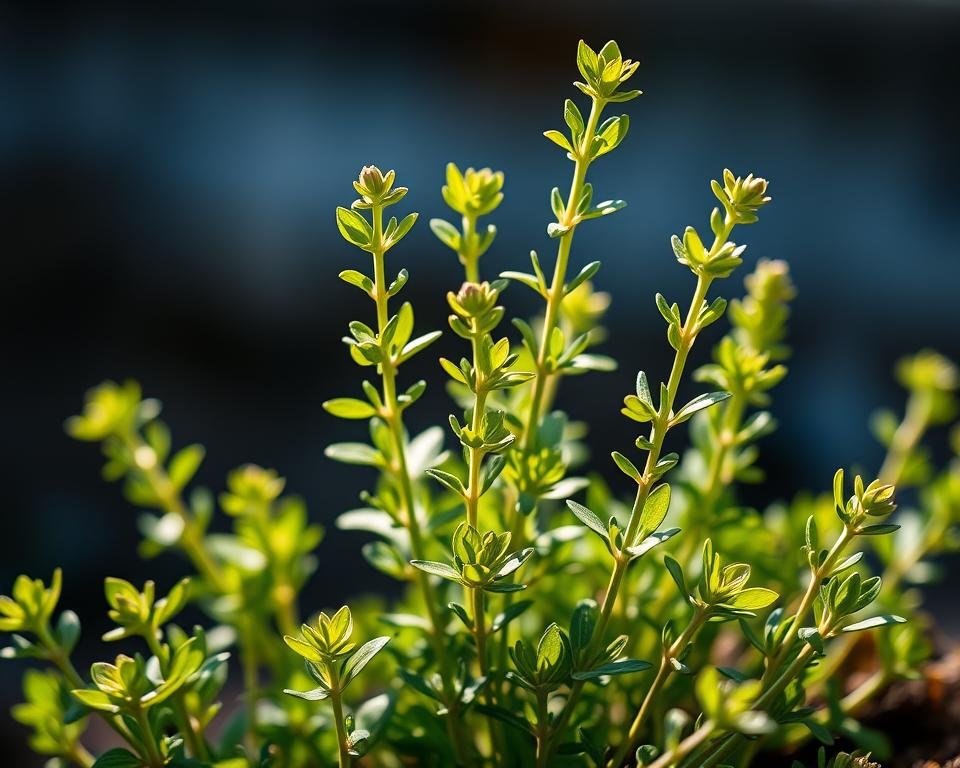How to Grow French Tarragon Herb Plant Everyone Is Using – Tips
There’s something magical about fresh flavors that transform ordinary meals into gourmet experiences. French tarragon does just that—its delicate anise-like taste has made it a staple in professional kitchens and home gardens alike.
Chefs adore this versatile herb for enhancing sauces, dressings, and poultry dishes. Gardeners love it for its low-maintenance nature and aromatic leaves. Whether you’re a seasoned cook or a budding green thumb, mastering its cultivation unlocks endless culinary possibilities.
In this guide, we’ll walk you through everything—from selecting the right variety to adapting it to your climate. You’ll discover why French tarragon thrives best with proper care and how its unique profile elevates dishes effortlessly.
Key Takeaways
- French tarragon adds a distinct, gourmet flavor to meals.
- It thrives in full sun and well-drained soil.
- Propagation works best through cuttings or root divisions.
- Perfect for sauces like béarnaise and vinaigrettes.
- Adaptable to various climates but prefers warmth.
Why French Tarragon Is a Must-Grow Herb
The secret to gourmet cooking often lies in one herb’s distinct, licorice-like flavor. French tarragon delivers this with finesse, making it a favorite among chefs and home cooks. Its delicate leaves add depth to sauces, meats, and even desserts.
A Flavor That Transforms Dishes
With its sweet, anise-kissed notes, this herb shines in classics like béarnaise sauce and fines herbes blends. It pairs perfectly with chicken, fish, and eggs. Unlike bold spices, it enhances without overpowering.
French vs. Russian vs. Mexican: Key Differences
French tarragon (the gold standard) offers the richest taste. Russian varieties, grown from seed, taste bitter and lack complexity. Mexican tarragon, a marigold relative, mimics the flavor but thrives in heat.
For true culinary quality, seek plants labeled “French” and propagated vegetatively. Seed-grown options often disappoint. In humid or hot climates, Mexican tarragon may be a practical alternative.
Chefs insist on the French variety for authenticity. Its scent alone evokes rustic French kitchens. Whether fresh or dried, it elevates dishes to restaurant-worthy status.
How to Grow French Tarragon Herb Plant Everyone Is Using
Quality begins at the source—choosing authentic plants ensures superior flavor. Unlike common herbs, this variety thrives through specific propagation methods. Skipping this step risks bland results.
Choosing the Right Variety for Your Garden
Beware of imposters. The Russian variety, often sold as seeds, lacks the delicate taste of true French tarragon. Always verify labels at garden centers—misidentification is common.
For guaranteed quality, purchase vegetatively propagated specimens. These retain the parent plant’s robust flavor profile. Seed-grown options rarely match up.
Why Propagation Happens Vegetatively
This herb rarely produces viable seed. Instead, it’s best multiplied through root division or stem cuttings. Here’s how:
- Root Division: In spring, use a sharp knife to split mature plants. Handle roots gently to avoid damage.
- Cuttings: Snip 4–8″ stems below a node. Dip in rooting hormone for faster growth.
Morning is ideal for taking cuttings—plants are hydrated. Transplant after frost passes for strong, healthy plants.
Preparing the Perfect Soil for French Tarragon
Healthy growth starts with the right foundation. French tarragon demands specific conditions to thrive, especially when it comes to soil. Without proper preparation, even the best plants struggle.
Ideal Soil pH and Composition
This herb prefers slightly alkaline to neutral ground. Aim for a pH between 6.5 and 7.5. Test kits from garden centers make checking easy.
Here’s what perfect soil looks like:
- Loamy texture – balances moisture retention and drainage
- Rich in organic matter – boosts nutrient availability
- Well-drained – prevents waterlogged roots
| Soil Type | Modification Needed | Result |
|---|---|---|
| Clay | Add 3″ compost + sand | Improved aeration |
| Sandy | Mix in 2″ peat moss | Better water retention |
| Average | 1″ compost topping | Enhanced fertility |
Enhancing Drainage With Organic Matter
Root rot spells disaster for this herb. Prevent it by ensuring proper drainage. Incorporate compost or organic matter to improve soil structure.
For problematic areas:
- Use raised beds in wet climates
- Select 12-15″ pots with drainage holes for container gardening
- Apply 2″ mulch to regulate moisture without waterlogging
Watch for warning signs like yellowing leaves or stunted growth. These indicate drainage issues needing immediate attention.
Planting French Tarragon: Step-by-Step
Timing and technique make all the difference when establishing this culinary favorite. Proper planting ensures vigorous growth and maximizes flavor production. Let’s explore the essentials for getting started.

Optimal Seasons for Establishment
Early spring reigns supreme for planting, right after frost dangers pass. Fall works well in warmer zones (7-10). Northern gardeners should wait until soil reaches 60°F for best results.
Spacing and Depth Fundamentals
Give plants room to flourish. Space them 24″ apart in garden beds. For depth, use the finger test: bury roots until the first set of leaves sits just above soil level.
| Method | Container Size | Spacing | Growth Rate |
|---|---|---|---|
| Pots | 12-15″ diameter | Single plant per pot | 20% slower |
| Ground | N/A | 24″ between plants | Faster establishment |
Container Versus Garden Bed Performance
Potted plants offer mobility but require more frequent watering. In-ground specimens develop stronger root systems. Consider your climate:
- Hot regions: Use light-colored containers to reflect heat
- Cool areas: Black pots absorb warmth for earlier starts
- Wet zones: Raised beds prevent waterlogging
Companion plants like rosemary create beneficial microclimates. Their similar water needs make them ideal partners. For container arrangements, lemon grass adds visual interest while deterring pests.
Sunlight and Temperature Needs
Balancing sunlight and temperature is crucial for unlocking this herb’s full potential. The right conditions ensure robust growth and intense flavor development. Let’s explore how to navigate seasonal challenges.
Sun Exposure by Climate
Six hours of daily sun works best in most regions. During summer heatwaves above 90°F, afternoon shade prevents leaf scorch. Observe these signs of stress:
- Curling or browning leaf edges
- Pale coloration
- Stunted new growth
| USDA Zone | Sun Preference | Special Considerations |
|---|---|---|
| 4-5 | Full sun | Winter mulch required |
| 6-8 | Morning sun + afternoon shade | Monitor soil moisture |
| 9-11 | Filtered sunlight | Grow as winter annual |
Weather Protection Strategies
Sudden frost damages tender shoots in early spring. Use these protective measures when temperatures drop unexpectedly:
- Cloches made from plastic bottles
- Floating row covers
- 2-3″ straw mulch around base
“South-facing walls create ideal microclimates for temperature-sensitive herbs in northern zones.”
In extreme heat, temporary shade cloth (30-40% density) prevents wilting. Always remove protections when weather stabilizes to avoid fungal issues.
Watering and Feeding Your Tarragon
Proper hydration and nutrition unlock the full potential of this culinary gem. Unlike thirsty plants, it thrives with moderate care once established. We’ll share pro tips to maintain ideal moisture levels while preserving its signature flavor.
Smart Watering Techniques
Weekly deep watering works best, allowing soil to dry slightly between sessions. Try the finger test—insert up to your second knuckle. If soil feels cool, wait another day.
Watch for these telltale signs:
- Overwatering: Yellowing lower leaves, mushy roots
- Underwatering: Crispy leaf edges, drooping stems
In drought conditions, mulch helps retain water. Established plants (2+ years old) handle dry spells better than newcomers.
Feeding for Flavorful Foliage
Miracle-Gro® Edibles Plant Nutrition delivers balanced nutrients without overpowering. Apply every 4-6 weeks during active growth. Always water before fertilizing to protect delicate roots.
| Fertilizer Type | Application | Best For |
|---|---|---|
| Liquid | Mixed in watering can | Quick nutrient boost |
| Granular | Worked into soil | Slow-release feeding |
| Organic compost | Top-dressing | Long-term soil health |
“Half-strength fertilizer solutions prevent flavor dilution while supporting growth.”
Skip feeding in late summer to harden plants for winter. Nutrient deficiency shows as pale leaves with dark veins—address immediately with foliar spray.
Pruning and Maintaining Healthy Growth
Keeping plants vibrant requires smart pruning and timely division. These practices prevent overcrowding and stimulate fresh, flavorful foliage. With simple techniques, we ensure continuous harvests season after season.
Mastering the Art of Pruning
Spring is ideal for removing browned foliage. Make clean cuts just above leaf nodes using sanitized shears. This encourages bushier new growth instead of leggy stems.
| Climate Zone | Best Pruning Time | Technique |
|---|---|---|
| 4-6 | Late April – May | Remove 1/3 of height |
| 7-9 | March – Early April | Shape and thin |
| 10-11 | Year-round | Light trimming |
Revitalizing Through Division
Every three years, divide mature specimens to maintain vigor. Follow these steps:
- Water thoroughly one day prior
- Dig around the root zone carefully
- Slice through roots with a sterile knife
“Divided plants show 40% more growth than congested ones in controlled studies.”
Replant divisions immediately, keeping soil moist. Discard woody center sections—they rarely recover well. For potted plants, refresh soil during division.
Troubleshooting Common Problems
Even the hardiest plants face challenges—knowing the signs keeps them thriving. Early detection saves leaves and roots from irreversible damage. Let’s tackle frequent issues with practical fixes.

Spotting and Stopping Root Rot
Root rot strikes when soil stays soggy too long. Check for a foul smell or blackened roots. If caught early, repotting in fresh, well-draining soil often revives plants.
| Symptom | Cause | Solution |
|---|---|---|
| Wilting despite wet soil | Fungal infection | Apply cinnamon or hydrogen peroxide drench |
| Yellow lower leaves | Overwatering | Reduce frequency; improve drainage |
When Leaves Turn Brown
Browning edges may signal dormancy in fall or stress in summer. For potted plants, boost air circulation. Trim damaged foliage to redirect energy.
- Seasonal change: Normal in cooler months
- Heat stress: Provide afternoon shade
- Nutrient lack: Try a balanced liquid feed
Pests: Rare but Possible
Spider mites appear in dry conditions. Wipe *leaves* with neem oil mix (1 tsp oil per quart of water). For aphids, blast them off with water or introduce ladybugs.
“Neem oil disrupts pests’ life cycles without harming beneficial insects.”
Prevent future problems with these steps:
- Water at the base to keep foliage dry
- Space plants for airflow
- Inspect weekly for early signs
Harvesting French Tarragon Like a Pro
Freshly picked leaves make all the difference in flavor. To maximize taste and plant health, timing and technique matter. Follow these steps to ensure a bountiful, aromatic yield.
Prime Harvest Windows
Spring and early fall offer the best time for picking. Cool mornings lock in essential oils, enhancing flavor. Avoid midday heat—leaves wilt quickly.
Cutting Without Harm
Use sharp scissors for clean cuts 6″ from stems tips. Never remove more than one-third of the plant. Rotate cutting areas to encourage new growth evenly.
| Method | Best For | Plant Impact |
|---|---|---|
| Scissors | Precise cuts | Minimal damage |
| Pinching | Quick harvests | Risk of tearing |
Look for bright green, flexible stems—these hold the richest flavor. Woody sections lack potency and slow regrowth.
Post-Harvest Care
Water lightly after picking to reduce stress. A balanced fertilizer helps recovery. Within weeks, fresh shoots will emerge, ready for another harvest.
“Rotational cutting extends productivity by 30% compared to random harvesting.”
Preserving and Storing Your Harvest
Capturing summer’s essence ensures year-round culinary magic. With the right techniques, those aromatic leaves can elevate dishes long after frost arrives. Let’s explore three foolproof ways to lock in flavor.

Drying for Intense Flavor
Air-drying works best for concentrated taste. Bundle stems with twine and hang them in a cool, dark spot. Avoid heat sources—they destroy delicate oils.
| Method | Time | Flavor Retention |
|---|---|---|
| Air-drying | 2–3 weeks | 90% |
| Dehydrator | 4–6 hours | 75% |
Store dried bundles in airtight jars away from light. Crush leaves just before use to release their full aroma.
Infused Vinegar and Frozen Cubes
For vibrant flavor, try vinegar infusions. Combine fresh sprigs with white wine vinegar for 3–4 weeks. Strain and bottle for dressings or marinades.
“Herb vinegars gain complexity over time—wait at least a month for peak flavor.”
Frozen herb cubes are another versatile option. Chop leaves finely, mix with olive oil, and freeze in ice trays. Pop one into soups or sauces anytime.
- Pro tip: Label containers with dates to track freshness.
- Use silica packets in storage jars to prevent moisture.
- Herb butter logs wrapped in parchment freeze well for 6 months.
With these methods, winter meals will taste like June’s bounty. Experiment to find your favorite preservation style.
Delicious Ways to Use French Tarragon
From sauces to seafood, this versatile herb transforms simple ingredients. Its licorice-like notes elevate both rustic and refined dishes. Whether fresh or dried, it’s a secret weapon for flavor-packed meals.
Perfect Pairings for Maximum Flavor
This herb shines alongside proteins with mild flavors. Try these classic combinations:
- Chicken: Rub leaves under the skin before roasting
- Fish: Mix chopped leaves into butter for grilled salmon
- Eggs: Fold into omelets or scrambled eggs
Must-Try Recipes
Béarnaise Sauce (5-minute version):
- Simmer 1/4 cup vinegar with minced shallots and 1 tbsp leaves
- Strain, then whisk into 3 egg yolks over double boiler
- Slowly add 1/2 cup melted butter until emulsified
“Tarragon’s flavor intensifies when heated briefly—overcooking turns it bitter.”
Herb Butter: Blend 1/2 cup softened butter with 2 tbsp chopped leaves. Roll into a log, freeze, and slice as needed for steaks or bread.
Beyond the Plate
Explore unconventional uses:
- Summer salads: Toss with watermelon, feta, and balsamic
- Cocktails: Infuse gin for 48 hours for a herbal twist
- Desserts: Steep in cream for vanilla bean ice cream
Conclusion
Growing this aromatic favorite brings joy through the months. From spring’s first sprouts to fall’s final harvest, each stage offers rewards. Even beginners can succeed with a sunny spot and well-drained soil.
Start small—a single pot on your patio or home windowsill works perfectly. The satisfaction of cooking with freshly picked leaves beats store-bought every time. Imagine enhancing dishes with flavors you nurtured yourself.
Share your journey! Whether it’s a thriving garden patch or a windowsill experiment, every success counts. Tag your photos or swap tips with fellow enthusiasts online.
Now’s the time to begin. With patience and care, you’ll soon enjoy this versatile herb in meals year-round. Happy growing—and even happier cooking!







